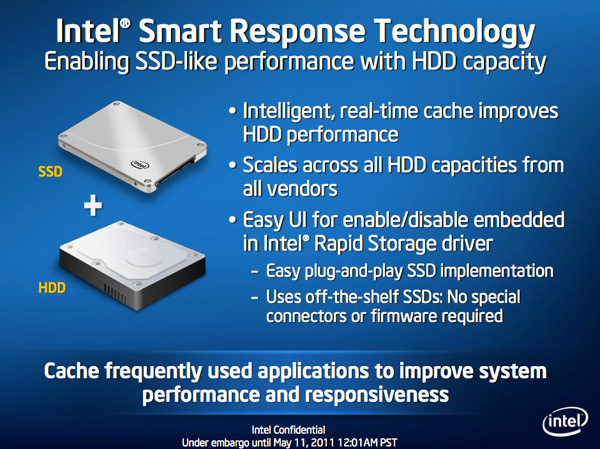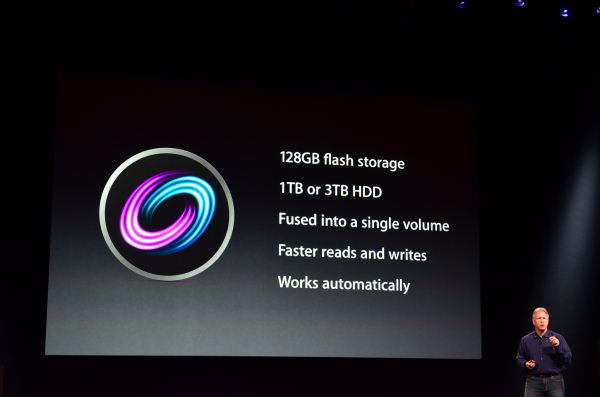A Month with Apple's Fusion Drive
by Anand Lal Shimpi on January 18, 2013 9:30 AM EST- Posted in
- Storage
- Mac
- SSDs
- Apple
- SSD Caching
- Fusion Drive
When decent, somewhat affordable, client focused solid state drives first came on the scene in 2008 the technology was magical. I called the original X25-M the best upgrade you could do for your system (admittedly I threw in the caveat that I’d like to see > 100GB and at a better price than $600). Although NAND and SSD pricing have both matured handsomely over time, there’s still the fact that mechanical storage is an order of magnitude cheaper.
The solution I’ve always advocated was a manual combination of SSD and HDD technologies. Buy a big enough SSD to house your OS, applications and maybe even a game or two, and put everything else on a RAID-1 array of hard drives. This approach works quite well in a desktop, but you have to be ok with manually managing where your files go.
I was always curious about how OEMs would handle this problem, since educating the masses on having to only put large, infrequently used files on one drive with everything else on another didn’t seem like a good idea. With its 6-series chipsets Intel introduced its Smart Response Technology, along with a special 20GB SLC SSD designed to act as a cache for a single hard drive or a bunch in an array.

Since then we’ve seen other SSD caching solutions come forward that didn’t have Intel’s chipset requirements. However most of these solutions were paired with really cheap, really small and really bad mSATA SSDs. More recently, OEMs have been partnering with SSD caching vendors to barely meet the minimum requirements for Ultrabook certification. In general, the experience is pretty bad.
Hard drive makers are working on the same problem, but are trying to fix it by adding a (very) small amount of NAND onto their mechanical drives. Once again this usually results in a faster hard drive experience, rather than an approximation of the SSD experience.
Typically this is the way to deal with hiding latency the lower you get in the memory hierarchy. Toss a small amount of faster memory between two levels and call it a day. Unlike adding a level 3 cache to a CPU however, NAND storage devices already exist in sizes large enough to house all of your data. It’s the equivalent of having to stick with an 8MB L3 cache when for a few hundred dollars more you could have 16GB. Once you’ve tasted the latter, the former seems like a pointless compromise.
Apple was among the first OEMs to realize the futility of the tradeoff. All of its mainstream mobile devices are NAND-only (iPhone, iPad and MacBook Air). More recently, Apple started migrating even its professional notebooks over to an SSD-only setup (MacBook Pro with Retina Display). Apple does have the luxury of not competing at lower price points for its Macs, which definitely makes dropping hard drives an easier thing to accomplish. Even so, out of the 6 distinct Macs that Apple ships today (MBA, rMBP, MBP, Mac mini, iMac and Mac Pro), only two of them ship without any hard drive option by default. The rest come with good old fashioned mechanical storage.
Moving something like the iMac to a solid state configuration is a bit tougher to pull off. While notebook users (especially anyone using an ultraportable) are already used to not having multiple terabytes of storage at their disposal, someone replacing a desktop isn’t necessarily well suited for the same.

Apple’s solution to the problem is, at a high level, no different than all of the PC OEMs who have tried hybrid SSD/HDD solutions in the past. The difference is in the size of the SSD component of the solution, and the software layer.










127 Comments
View All Comments
edlee - Friday, January 18, 2013 - link
I get the cached solution for fusion. But I would rather just handle the usage myself and have os and applications on SSD and all media on a Raid array.SSD for life.
Death666Angel - Friday, January 18, 2013 - link
It looks better than I thought. I'm still not going to use it myself (Windows/Linux user here and I have no trouble managing more than one partition). But it seems better than the usual Windows caching solutions. Still, the non-technical people I know don't need more than a few hundred GB of space on their PC and no one has more than one HDD in their PC anyway. So the easiest way for them (which is what I always recommend) is to have a 256GB SSD and an external 1 to 3TB drive. All their work is on the SSD with daily/weekly backups and photos are on their external HDD (none of those people use the PC to view movies).tipoo - Friday, January 18, 2013 - link
If you write a huge file, it all gets written to the SSD up to 117GB. But that SSD is filled with other stuff. Won't it be limited by the speed it transfers the old things to the hard drive? How does that work if the files aren't mirrored?name99 - Friday, January 18, 2013 - link
Read the damn article before posting. ALL those questions are answered there.ltcommanderdata - Friday, January 18, 2013 - link
Apple still lists the 3TB Fusion drive as incompatible with Boot Camp "at this time". Presumably this is due to how Apple is doing the BIOS emulation with EFI 1.10 and running into the 2.2TB drive size limit. Have you heard any methods to get 3TB Fusion working with Boot Camp or heard whether Apple has a solution in the works?tipoo - Friday, January 18, 2013 - link
Just curious, I think that's how Readyboost worked. You would have a flash drive immediately start sending data slowly to your computer while the hard drive took its time to seek the larger chunks of data. So I wonder if there is a large queue of data for a Fusion drive to read, it will read from both drives concurrently?tipoo - Friday, January 18, 2013 - link
"In less than a year Apple could double the size of the NAND used in Fusion Drive at no real change to cost."But will they? If the iPods, iPhones, and iPad are any indication, they will more likely pocket the savings. Been a long time since a capacity doubling from them.
name99 - Friday, January 18, 2013 - link
Oh for fscks sake.The iPod nano1 came in sizes of 1, 2, 4GB
The 2nd gen came as 2, 4, 8GB.
3rd were 4, 8GB
4th was 4,8, 16GB.
All at essentially the same retail price.
Apple has showed consistent pattern (you also see it in the shuffle, or in iPod Touch), of doubling the storage until they hit a point which seems to cover almost everyone's needs. Then there is a year or two of stasis, then a new product category which requires more storage.
Next time you want to post blatant nonsense, try to remember that on the internet people WILL call you out when you state bullshit.
tipoo - Friday, January 18, 2013 - link
Feeling self-important today? Yes, that's what I mean, there hasn't been a doubling since the fourth generation Nano. Or does "Been a long time since a capacity doubling from them" mean "they have never ever doubled capacity" in your little world?tipoo - Friday, January 18, 2013 - link
"Then there is a year or two of stasis, then a new product category which requires more storage."Like the iPads, which would be ideal for storing HD video if not for the exorbitant prices of higher capacities, with zero bump for the base price since the first one?